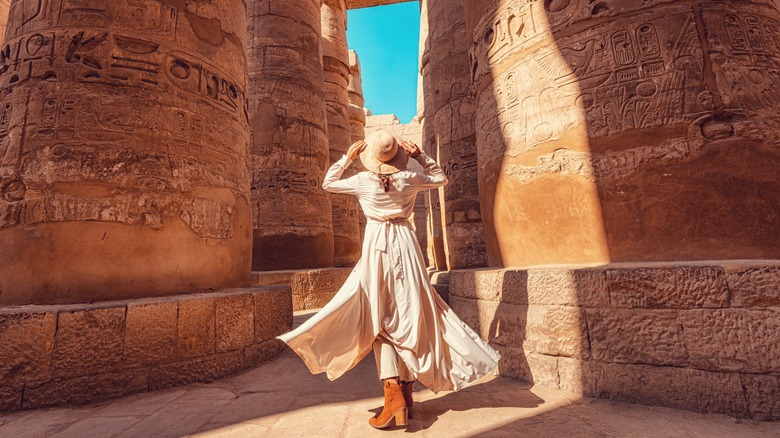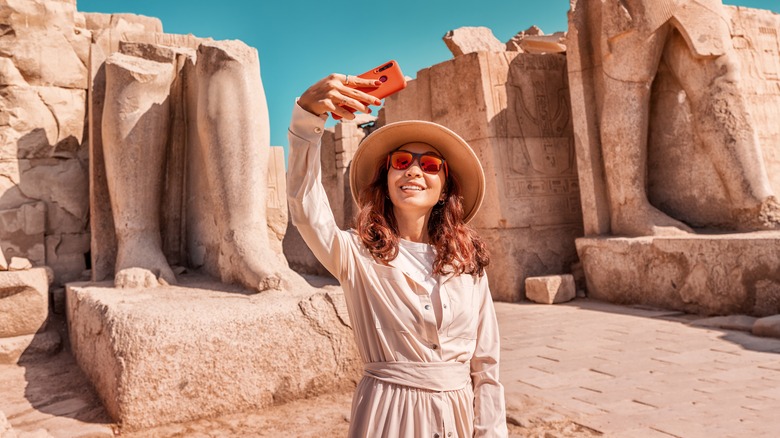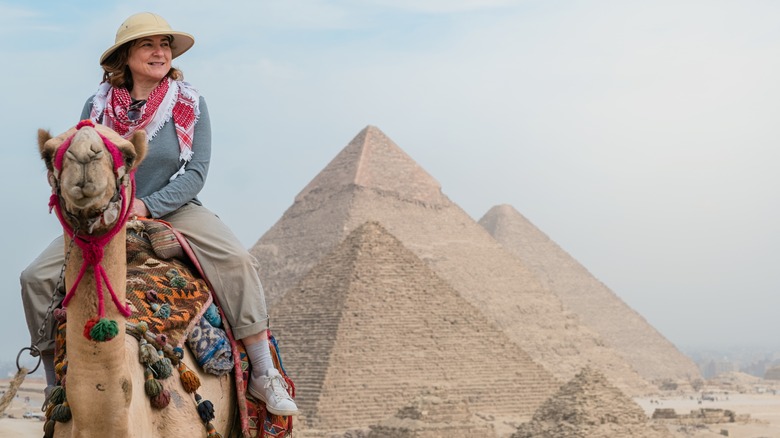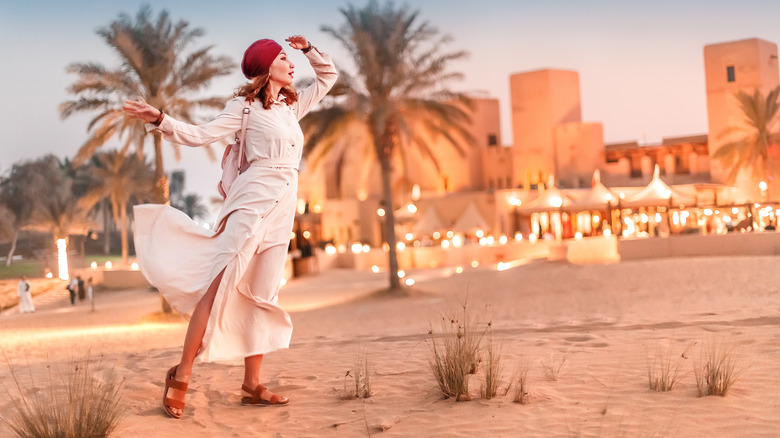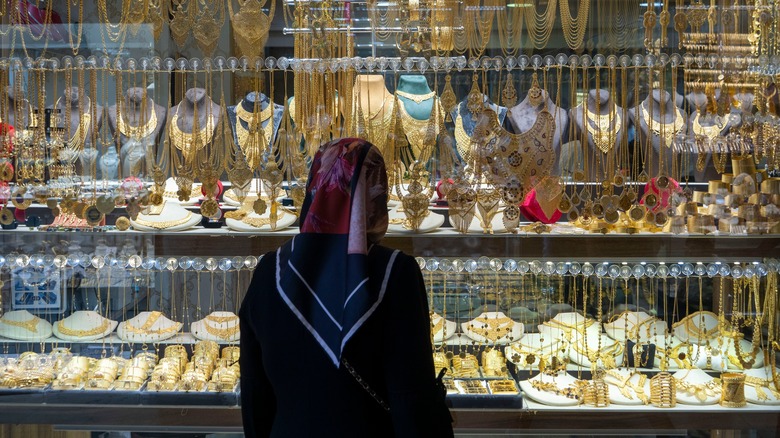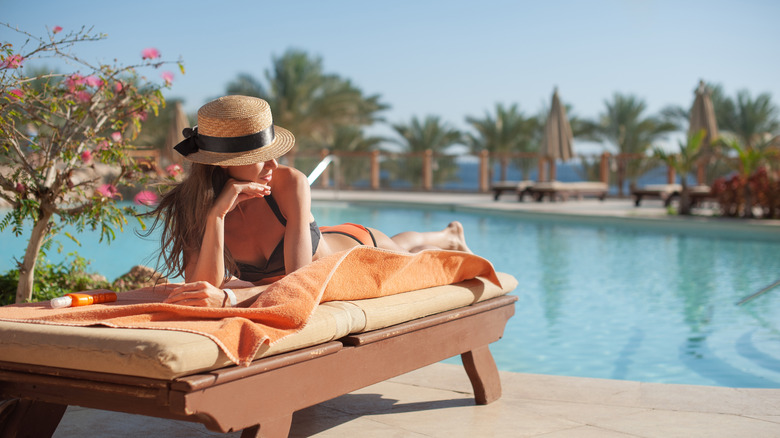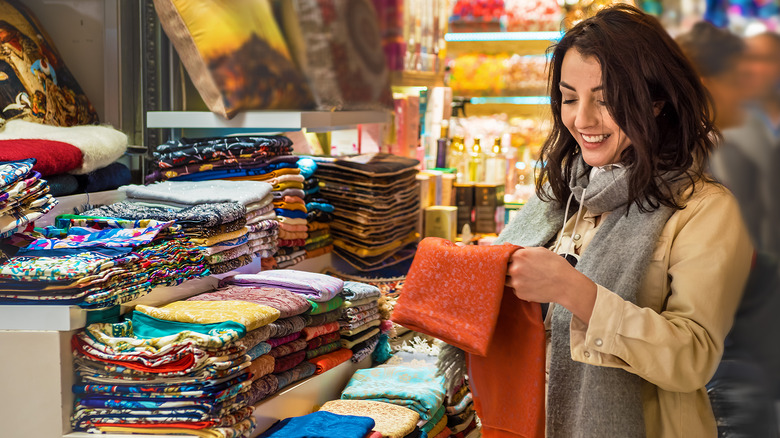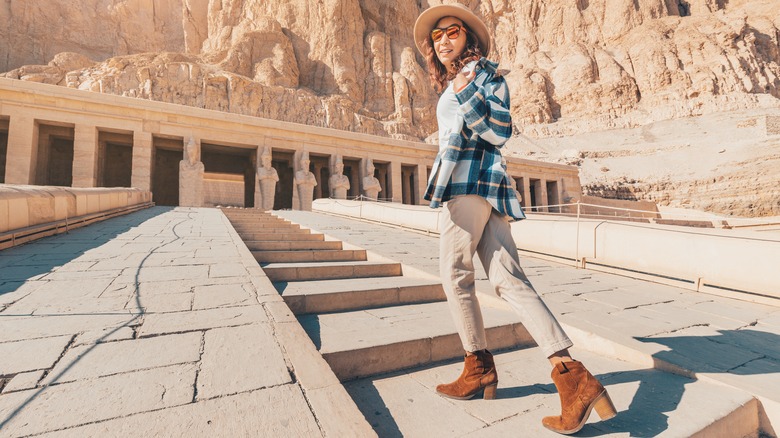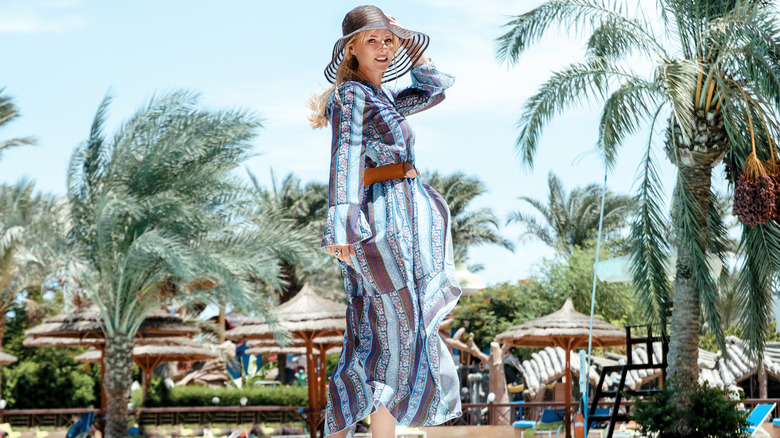What To Wear In Egypt: Packing Tips For Female Travelers
For many travelers, Egypt is at the top of their bucket list. Between its ancient history, rich culture, delicious food, and those iconic pyramids, it's really no wonder that Egypt is also one of the 50 places we believe you need to visit in your lifetime. However, before you hop on that flight, packing the right items will be one of the first steps to ensuring you have a wonderful, stress-free vacation. Whether you're packing light, trying to pack a carry-on for a 3-week vacation, or going all out with a checked bag, there are some special considerations you'll need to make, especially as a female traveler.
Egypt is one of the most conservative countries in the world, per Insider. That impacts all aspects of life and for women, it includes how they are expected to dress. As HuffPost notes, Egypt is a predominantly Muslim country and most women wear either a hijab covering their hair and neck or a niqab, which also covers most of their face, leaving only the eyes exposed. While visitors aren't expected to follow the same strict rules, there are definitely some things you'll want to leave out of your suitcase. Here's how to pack the right pieces to avoid common clothing mistakes and enjoy your time exploring Cairo and beyond.
Appropriate tops to wear in Egypt
Given how conservative Egypt is, you'll want to opt for modest tops that fully cover your shoulders and show no cleavage, per Mara House Luxor. Covering your midriff is also essential and while your arms can be exposed, A Dangerous Business notes that covering your elbows is preferred. She herself opted for three-quarter sleeve tops to be respectful of the local culture. In addition to coverage, the fit of your clothes also matters. Rather than body-hugging silhouettes, Mike & Laura Travel recommends opting for loose, flowy tops and leaving anything that is sheer or features mesh panels (looking at you, workout tops!) at home. And if you really want to wear your fave top or dress which happens to have thin straps or a low neckline, Osiris Tours recommends a great hack: layer a shirt underneath it or right on top.
Finally, you'll want to consider fabric carefully. Between April and November, temperatures can soar from around 80 degrees in spring and fall to an average of 95 degrees in the summer, per TripSavvy. Temperatures have even been known to hit 122 degrees during summer months, which means that lightweight, breathable fabric will be your best friend if you're visiting during that time. Cotton and linen should top your list as they won't weigh you down under the scorching sun. Alternatively, silk is also an exceptionally breathable material, per REI.
Choosing the right bottoms for an Egypt trip
Just like with tops, conservative is the name of the game when choosing the perfect bottoms. A long skirt, flowing palazzo pants, or maxi dress are all great options providing coverage while not being overtly figure-hugging. However, the most important rule of thumb to remember is to keep your knees covered, per A Dangerous Business. That means capris or calf-length skirts are also acceptable. In other words: shorts and mini skirts are a total no-go, per Mike & Laura Travel, unless you're inside a tourist-centric resort.
Again, you'll want to choose breathable fabrics like cotton and linen, especially if you're planning to travel in the summer months. Alternatively, if you're going to visit Egypt around winter when temperatures can drop to the mid-60s, per TripSavvy, you can pack your skinny jeans (locals wear them too) but with a caveat: pair them with a longer top or tunic that covers your buttocks. The same is true of leggings, which are acceptable when worn with a longer shirt, per Osiris Tours. Leggings can also come in handy if your favorite dress or skirt hits at or above the knee. As Alison, an American journalist living in Cairo, told HuffPost, "Your conservative equals their slightly-less-scandalous, so skinny jeans need a long shirt, and even a high-neck shirt must either be loose or be layered with a loose sweater."
Covering your hair in Egypt
Many female travelers planning to visit Egypt wonder if they will need to cover their hair. It is a valid concern as over 90% of women in the country do wear a headscarf, per The New York Times (via Washington Institute). Ultimately, however, it is your choice as it's not mandatory for tourists to wear a hijab, unless they are visiting a mosque, per A Dangerous Business. That being said, you may find you feel more comfortable joining the majority. As Alex on the Map shared, she planned to visit Egypt without wearing a headscarf but changed her mind after spending a few days there. In her experience, covering her hair made her more comfortable in big crowds as it helped her blend in and draw less unwanted attention. Another upside of covering up is that you'll be protected from the scorching sun.
Interestingly, hijabs have become a point of contention in Egypt. In 2020, the AP reported that some high-end restaurants, as well as many bars and clubs, have actually banned women who wear headscarves. Doaa Mohamed, who wasn't allowed to enter a bar because of her hijab, told AP, "To establishments, women who wear the headscarf are from low or middle classes that [they] don't want to serve."
What about jewelry?
As with any trip, you should think twice before packing anything overly valuable. If you have jewelry that's particularly expensive or meaningful to you and you couldn't stand to lose it, leave it at home, just in case. Opting to leave your bling behind will also ensure you don't attract unwanted attention from paupers or pickpockets, per Mike & Laura Travel. What's more, Mara House Luxor points out that wearing rings in Egypt's scorching heat isn't a good idea anyway because your fingers are likely to swell and you'll have a hard time taking them off.
That being said, many Egyptian women do wear jewelry. As TripAdvisor user Catherine S (who lives in Cairo) points out, "You will find those not wearing jewelry in Egypt in the minority." Indeed, you'll come across plenty of shops and markets selling gold jewelry, so you can pick up a new piece while you're there. Before you go shopping, though, Third Eye Traveller has some tips to keep in mind. She herself was overcharged while buying a gold necklace and recommends doing your research to find a reputable shop, knowing that day's market price for gold, and demanding to see the weight of your piece, along with an invoice that clearly states it.
Acceptable swimwear, explained
Given all of the conservative clothing guidelines we've shared so far, choosing the right swimsuit may feel like a daunting, if not impossible, task. In reality, what you wear will depend on where you're planning to swim. As Family Travel in the Middle East explains, if you're hitting your hotel's pool or are hanging out on a resort's private beach, you can wear whatever you like. Yes, even a bikini is acceptable, as long as you throw a cover on when you leave the water or your lounge chair. In fact, blogger This Rare Earth spotted plenty of two-piece suits at her hotel.
Alternatively, if you're heading to a public beach, things become a little trickier. A one-piece bathing suit is more advisable as it's more modest, but even then, Sea View Hotel recommends taking a moment to look around you and see what others are wearing. If the beach is mostly being used by locals rather than tourists, you're likely to draw attention, as most local women wear burkinis that cover their entire bodies. In that case, you may find you're more comfortable taking a dip at your hotel instead. Interestingly, AP reported in 2020 that some high-end resorts have actually banned burkinis, sparking outrage from some local women.
A scarf is essential
If there is one thing you absolutely need to pack for your trip to Egypt, it's a lightweight scarf, shawl, or pashmina. This simple accessory seems to be on all female travelers' must-have lists thanks to its versatility. As Osiris Tours notes, you'll undoubtedly find many uses for it during your stay, regardless of which season you're visiting. For one, a scarf can be used to cover your neckline or shoulders, instantly making your outfit more modest. If you're planning to visit any mosques during your trip, you can also use it to cover your hair, per Mike & Laura Travel, as is mandatory in places of worship.
Additionally, a scarf can protect your head from the sun, provide added warmth on a chilly night, or shield you from a sandstorm. It may sound like something out of a movie, but sandstorms are very real and they do happen in Egypt from March to May. During that time, winds can reach speeds of 56 miles per hour, per AP, blowing dust from the desert every which way. A shawl can help protect your nose, mouth, and skin from irritation. Pack one (or several!) in your suitcase and make sure you always have one handy in your bag when you leave for a day of sightseeing.
Remember: It's not always hot in Egypt
Think of visiting Egypt and you'll likely picture yourself in the desert, looking up at majestic pyramids under a scorching hot sun. While that's definitely true during the summer months, Egypt isn't actually hot all the time. Rather, it experiences a mild, sometimes chilly, winter with temperatures that average in the low to mid-60s, per TripSavvy. Although you're unlikely to experience any days under 50 degrees, Curated Taste still recommends packing both a light jacket and a sweater for the daytime, as well as a thicker coat you can wear for nighttime exploring.
Throwing gloves and a hat into your suitcase is also a good idea, as is packing pieces that can be layered, per What to Wear on Vacation. That way, you can easily pull them on and off throughout the day as temperatures rise and fall. In fact, you'll also want to pack a windbreaker or light jacket if you're visiting in the spring or fall because temperatures do tend to dip in the evenings.
Don't forget the accessories
A few final things to consider while packing for your trip to Egypt are the essential finishing touches to any outfit. A wide-brimmed hat or baseball cap, along with sunglasses, are must-haves to help shield you from the sun. As Mike & Laura Travel point out, the latter can play double duty if you get caught in a sandstorm as glasses will help protect your eyes. Rough Guides also adds that wearing sunglasses is a good way for female visitors to fend off unwanted attention as they'll ensure you can avoid making eye contact with local men.
Now, for shoes. You can certainly pack a pair of sandals for the hotter days, but Mike & Laura Travel notes you may actually find closed-toe shoes to be comfier year-round because they'll keep your feet sand-free. However, what you absolutely can't leave the house without is a pair of comfortable sneakers you can wear and walk around in, hopefully offering plenty of support as you explore historic sites.
Last but not least, don't forget your umbrella. Julie Off Duty found it essential to keep the burning sun off her skin. What's more, if you travel between November and March, it'll also come in handy during any possible rain showers, per TripSavvy.
